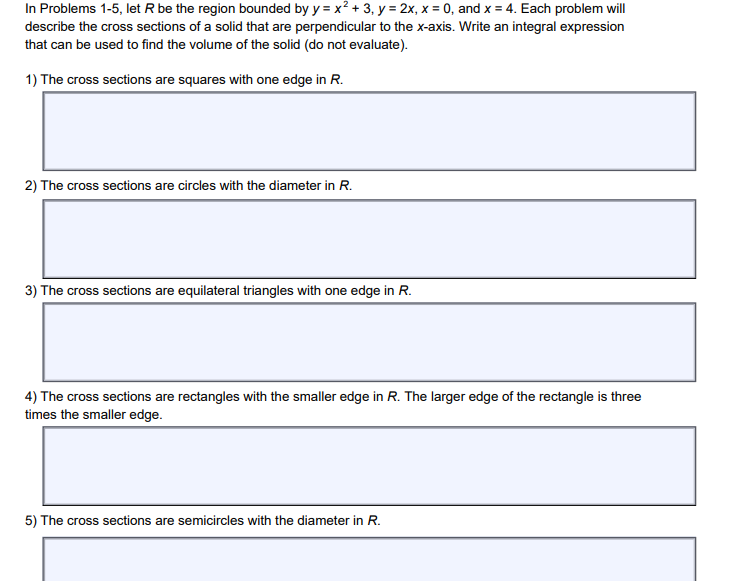In Problems 1-5, let R be the region bounded by y = x² + 3, y = 2x, x = 0, and x = 4. Each problem will describe the cross sections of a solid that are perpendicular to the x-axis. Write an integral expression that can be used to find the volume of the solid (do not evaluate). 1) The cross sections are squares with one edge in R. 2) The cross sections are circles with the diameter in R. 3) The cross sections are equilateral triangles with one edge in R. 4) The cross sections are rectangles with the smaller edge in R. The larger edge of the rectangle is three times the smaller edge. 5) The cross sections are semicircles with the diameter in R.
In Problems 1-5, let R be the region bounded by y = x² + 3, y = 2x, x = 0, and x = 4. Each problem will describe the cross sections of a solid that are perpendicular to the x-axis. Write an integral expression that can be used to find the volume of the solid (do not evaluate). 1) The cross sections are squares with one edge in R. 2) The cross sections are circles with the diameter in R. 3) The cross sections are equilateral triangles with one edge in R. 4) The cross sections are rectangles with the smaller edge in R. The larger edge of the rectangle is three times the smaller edge. 5) The cross sections are semicircles with the diameter in R.
Calculus: Early Transcendentals
8th Edition
ISBN:9781285741550
Author:James Stewart
Publisher:James Stewart
Chapter1: Functions And Models
Section: Chapter Questions
Problem 1RCC: (a) What is a function? What are its domain and range? (b) What is the graph of a function? (c) How...
Related questions
Question
Please, I need 1 to 5

Transcribed Image Text:In Problems 1-5, let R be the region bounded by y = x² + 3, y = 2x, x = 0, and x = 4. Each problem will
describe the cross sections of a solid that are perpendicular to the x-axis. Write an integral expression
that can be used to find the volume of the solid (do not evaluate).
1) The cross sections are squares with one edge in R.
2) The cross sections are circles with the diameter in R.
3) The cross sections are equilateral triangles with one edge in R.
4) The cross sections are rectangles with the smaller edge in R. The larger edge of the rectangle is three
times the smaller edge.
5) The cross sections are semicircles with the diameter in R.
Expert Solution
This question has been solved!
Explore an expertly crafted, step-by-step solution for a thorough understanding of key concepts.
This is a popular solution!
Trending now
This is a popular solution!
Step by step
Solved in 3 steps with 2 images

Recommended textbooks for you

Calculus: Early Transcendentals
Calculus
ISBN:
9781285741550
Author:
James Stewart
Publisher:
Cengage Learning

Thomas' Calculus (14th Edition)
Calculus
ISBN:
9780134438986
Author:
Joel R. Hass, Christopher E. Heil, Maurice D. Weir
Publisher:
PEARSON

Calculus: Early Transcendentals (3rd Edition)
Calculus
ISBN:
9780134763644
Author:
William L. Briggs, Lyle Cochran, Bernard Gillett, Eric Schulz
Publisher:
PEARSON

Calculus: Early Transcendentals
Calculus
ISBN:
9781285741550
Author:
James Stewart
Publisher:
Cengage Learning

Thomas' Calculus (14th Edition)
Calculus
ISBN:
9780134438986
Author:
Joel R. Hass, Christopher E. Heil, Maurice D. Weir
Publisher:
PEARSON

Calculus: Early Transcendentals (3rd Edition)
Calculus
ISBN:
9780134763644
Author:
William L. Briggs, Lyle Cochran, Bernard Gillett, Eric Schulz
Publisher:
PEARSON

Calculus: Early Transcendentals
Calculus
ISBN:
9781319050740
Author:
Jon Rogawski, Colin Adams, Robert Franzosa
Publisher:
W. H. Freeman


Calculus: Early Transcendental Functions
Calculus
ISBN:
9781337552516
Author:
Ron Larson, Bruce H. Edwards
Publisher:
Cengage Learning